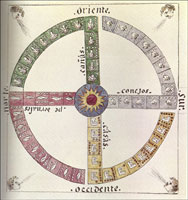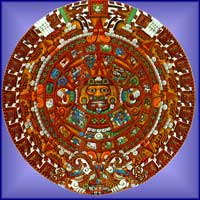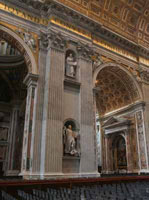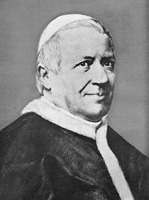| The
American Pope!! |
On March 12, 2013, I predicted that the next Pope would be an American Pope. Here is the dictionary definition of AMERICAN:
1. Of or relating to the United States of America or its people, language, or culture.
2. Of or relating to North or South America, the West Indies, or the Western Hemisphere.
3. Of or relating to any of the Native American peoples.
4. Indigenous to North or South America. Used of plants and animals.
Based on the great prophecy of the 1260-year occupation of the city of Rome, I predicted that he would be the last Pope and that he would take the Roman name Pius XIII.
Obviously, the Jesuits don't believe that the occupation of Rome will end soon, because they scoff at the prophecies in the Holy Bible. However, they are fanatical believers in astrology, horrorscopes, and "lucky days" to launch their sinister schemes.
This is almost beyond belief because a Jesuit named Galileo made astrology obsolete by making the sun . . . and not the earth . . . the center of the universe!!
Bergoglio's parents were born in Italy and Argentina was the preferred destination for escaping Fascists and Nazis like Adolf Hitler....Perhaps he even met the former Führer and they shared some "tricks of the trade."
13 was the sacred number for the Aztecs of Mexico!!
13 was the sacred number for the "sacred heart" worshipping Aztecs of Mexico.
Jorge Mario Bergoglio was elected Pope on 3-13-2013. After the mandatory sex-check by the Vatican physician, he was introduced to the world as Pope Francis I—the vicar of Jupiter.
In the Book of Esther, Haman (a type of the Papacy), cast a horrorscope for 12 months, and on the 13th day of the 12th month he discovered that the 13th day of the 12th month of the following year would be the "lucky day" for the Jewish holocaust:
In the first month, that is the month Nisan, in the twelfth year of king Ahasuerus (Xerxes), they cast Pur, that is the horoscope, before Haman from day to day, and from month to month, to the twelfth month, that is the month Adar. (Esther 3:7).
The Persian word Pur means casting a horoscope or divination by astrology:
You are wearied in the multitude of your counsels; let now the astrologers, the stargazers, and the monthly prognosticators stand up and save you from what shall come upon you (Isaiah 47:13).
The English word prognosticate, from the Latin prognosticum, means to foresee, augur, foretell, or vaticinate. Before Jesuit Galileo "discovered" that the earth was rotating and not at the center of the universe, horoscopes were all the rage at Rome.
That is why the Vatican is called the "See" of Peter or the "Holy" See.
Haman's horoscope told him that the 13th day of the following 12th month would be the "lucky day" for the Jewish holocaust:
And the letters were sent by posts into all the king's provinces, to destroy, to kill, and to cause to perish, all Jews, both young and old, little children and women, in one day, even upon the thirteenth day of the twelfth month, which is the month Adar, and to take the spoil of them for a prey. (Esther 3:13).
This was almost the ancient world's equivalent of the Saint Bartholomew's Day Massacre.
If you want to see the depths of Satan, all you have to do is study the Aztec kingdom of Mexico, with the vast multitude of hearts ripped out and sacrificed to the demon sun god Huitzilopochtli.
|
The Aztec calendar contained a week of thirteen days, and this week synchronized perfectly with their month of 20 days. Here is an account of the Aztec calendar by a Dominican monk named Fray Diego Durán:
Now that we have described and spoken of the months and days and of their signs, it now behooves us to deal with the weeks and explain their order. Regarding our first theme, it must be noted that the native "week" was composed of thirteen days, just as ours is made up of seven. And it was counted from one to thirteen. The year contained exactly, precisely, twenty-eight weeks, because, in order to adjust their years and weeks with precision (as we saw in Chapter I), the years were counted thirteen by thirteen. And so it was that the months and the weeks were adjusted so well and in such good order that the calendrical count these people used was admirable and highly ingenious. (Durán, Book of the Gods and Rites and the Ancient Calendar, p. 405).
The Aztec calendar existed for one reason: divination by horoscope:
We have described how the symbols of the months and days were used to foretell the good or bad fates of those who were born. Thus, when a boy or girl was born, the father or relative of the babe immediately went to visit the astrologers, sorcerers, or soothsayers, who were plentiful, begging them to state the destiny of the newborn boy or girl. The inquirer always carried with him offerings of food and drink. The astrologer and sorcerer-fortuneteller brought out the Book of the Horoscope, together with the calendar. Once the character of the day had been seen, prophecies were uttered, lots were cast, and a propitious or evil fate for the babe was determined by the consultation of a paper painted with all the gods they adored, each idol drawn in the square reserved for him. (Durán, Book of the Gods and Rites and the Ancient Calendar, p. 398).
Absolutely nothing happened in the diabolical Aztec kingdom without first consulting the horoscope and calendar.
Most of the history of the Aztecs was destroyed by Hernán Cortés, but Fray Diego managed to construct some of their history by interviewing the surviving natives. Fray Diego was amazed by the parallel between the Atzec and Roman religion, but he attributed the similarity to the devil sowing tares in the wheat!
The Papal Roman Empire is also based on the number 13. Emperor Constantine the Druid conquered the city of Rome in October 312, but the Constantinean Revolution was not complete until January 313 when the Roman Senate officially recognized Constantine as the first "Christian" Emperor:
And here is the mind which hath wisdom. The seven heads are seven mountains on which the woman sitteth. And there are seven kings: five are fallen, and one is, and the other is not yet come; and when he cometh, he must continue a short space. (Revelation 17:9-10).
7 + 5 + 1=13 |
The Book of Revelation is the last Book in the Bible and numbers are used symbolically to reveal future events to the Christians . . . or conceal future events from the enemies of the Gospel of Christ....Almost every verse in that blessed prophetical book contains a numerical code or cipher.
The Militia of Zeus and Minerva!!
Jorge Mario Bergoglio is the first Jesuit Pope, so this is the first time in history when there are 2 Jesuit Popes serving simultaneously.
|
A picture is worth a thousand words and the images below reveal very clearly the goals of the Militia of Zeus and Minerva.
The Jesuits look on the Bible as a SERPENT because it condemns everything they believe and do. Here is an excerpt from a book written in 1848 exposing the Jesuit Conspiracy:
Then the Bible, that serpent which, with head erect and eyes flashing fire, threatens us with its venom whilst it trails along the ground, shall be changed again into a rod as we are able to seize it; and what wounds will we not inflict with it upon these hardened Pharaohs and their cunning magicians! what miracles will we not work by its means! Oh, then, mysterious rod! we will not again suffer thee to escape from our hands, and fall to the earth!
For you know but too well that, for three centuries past, this cruel asp (crudele aspide) has left us no repose; you well know with what folds it entwines us, and with what fangs it gnaws us! (Leon, The Jesuit Conspiracy, p. 98).
666 equals Lateinos in Greek
The Greeks, like the Romans, did not have Indian numerals like 1,2,3,4; so each letter of the Greek alphabet represented a number. Alpha was 1, beta was 2, etc., etc. It is totally useless to try and calculate the number of the Beast in any other language but Greek.
|
|
|
Lateinos is the oldest and most common interpretation of the number of the Beast. Lateinos signifies Latin MAN or Latin kingdom, and is also the name of the king who founded the Latin state, namely King Latinus.
The oldest writings that survived the last great pagan persecution is that of Saint Irenaeus who lived from about 120 to 200 AD.... Saint Irenaeus is most famous for his prediction that the world would last for 6,000 years....Saint Irenaeus was a disciple of Polycarp, who was a disciple of the Apostle John, who wrote the Book of Revelation:
For if there are many names found possessing this number, it will be asked which among them shall the coming man bear. It is not through a want of names containing the number of that name that I say this, but on account of the fear of God, and zeal for the truth: for the name Evanthas contains the required number, but I make no allegation regarding it. Then also Lateinos has the number six hundred and sixty-six; and it is a very probable [solution], this being the name of the last kingdom [of the four seen by Daniel]. For the LATINS are they who at present bear rule: I will not, however, make any boast over this [coincidence].Teitan too, the first syllable being written with the two Greek vowels e and i, among all the names which are found among us, is rather worthy of credit. For it has in itself the predicted number, and is composed of six letters, each syllable containing three letters; and [the word itself] is ancient, and removed from ordinary use; for among our kings we find none bearing this name Titan, nor have any of the idols which are worshipped in public among the Greeks and barbarians this appellation. Among many persons, too, this name is accounted divine, so that even the sun is termed Titan by those who do now possess [the rule]. (Saint Irenaeus, Against Heresies, Book V, ch. 29).
Saint Irenaeus mentioned 3 names: Evanthas, Lateinos, and Teitan or Titan. The meaning of Evanthas is obscure, but Lateinos is the code word for the Romans:
The 1260-Year Occupation of Rome by the Papacy!!
The Book of Daniel and the Book of Revelation predicted the rise, reign, decline and fall of the Papal Roman Empire; also called the Beast, Antichrist, or the Man of Sin.
This occupation of the 7-hilled city of Rome is given as a symbolic time period of 1260 days. In Bible prophecy, a day symbolizes a year (Numbers 14:34, Daniel 9:25, Ezekiel 4:6, Revelation 11:3).
In 313, Emperor Constantine was recognized as the first "Christian" Emperor by the Roman Senate. This date can be considered as the official beginning of the Papal Roman Empire.
In 1588, the "Invincible" Spanish Armada was defeated and this date was the official beginning of the decline and fall of Papal Rome.
In the year 606, Roman Emperor Phocas, who reigned from New Rome or Constantinople, conferred on Pope Boniface III the title: Universal Bishop. This was the official beginning of the claim of the Papacy to universal dominion.
The year 755 was another milestone in the rise of the Papacy. In that year, King Pepin of the Franks gave Pope Stephen II dominion over the city of Rome and all of central Italy. This date was the official beginning of the temporal power of the Roman Pontiffs.
Beginning |
Years |
Ending |
Year
of actual fulfillment |
313 |
1260 |
1573 |
1588 |
606
|
1260
|
1866 |
1870 |
755 |
1260 |
2015 |
20?? |
Milestones
in the rise and fall of the Papal Roman Empire. |
All of the Bible Commentaries written before 1866 predicted that 1866 would be a milestone in the decline of Papal Rome. Many of the Commentaries were bestsellers throughout Europe and the U.S. They were off by only 4 years because the occupation ended on September 20, 1870.
|
|
|
|
Within weeks, the Prussian army was outside Paris, and the French army protecting Pope Pius IX had to be withdrawn from Rome. Bismarck sent observers to the U.S. Civil War and they noted the deciding factor that the telegraph and the railroad played in the great Union victory.
The Prussian army was quick to adopt these new innovations in warfare and that was the vital factor in their lightning victory over the troops of Napoleon III.
On September 20, the Italian army, led by general Cadorna, liberated occupied Rome, and the Papal States were gone forever!!
On February 11, 1929, Italian dictator Benito Mussolini signed the Lateran Treaty which gave Pope Pius XI a small area of Rome called Vatican City State as a temporary headquarters!!
Vital links
References
Durán, Fray Diego, Book of the Gods and Rites and the Ancient Calendar. Translated and edited by Fernando Horcasitas and Doris Heyden, University of Oklahoma Press, Norman, OK, 1971.
Van Dam, Raymond, The Roman Revolution of Constantine. Cambridge University Press, New York, 2007.
The Abbate Leon, The Jesuit Conspiracy: The Secret Plan of the Order. Chapman and Hall, London, 1848.
Copyright © 2013 by Patrick Scrivener









